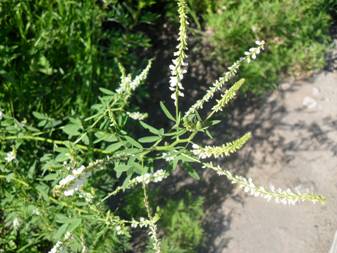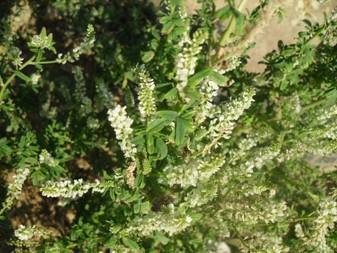


Sweetclover (Melilotus), fam. Fabaceae.
There are two species along some of the city roads – White Sweetclover (Melilotus alba), with white flowers, and Yellow Sweetclover (Melilotus officinalis). They are much more abundant in southern steppe regions, where these plants are among the favorite food of goats and other cattle. We, the humans, are also encharmed with the honey-smelling fields of sweetclover in the middle of summer. The plant has great melliferous value – for example, in the USA, where it is not native, it has now become one of the primary honey-bearing cultures. Sweetclover positively affects the soil composition and structure – due to nitrogen enrichment, salinity removal, and stopping erosion. However, this plant cannot grow on acid and waterlogged soils, which are not rare around Kyiv.
The Russian name relates to using for traditional treatment of lower-abdomen diseases, particularly in women. Yellow sweetclover is used more often, since the white species contains more coumarines, so it is even included into the list of toxic plants. Coumarines decrease blood clotting, which can be beneficial for trombosis, but the overdose is dangerous due to bleeding. This also limits the use of sweetclover as fodder, with an exception for some special low-coumarine varieties.
Other uses of sweetclover are to repel the insects (mosquitoes and mothes), as aromatizer, and as a source of fiber.